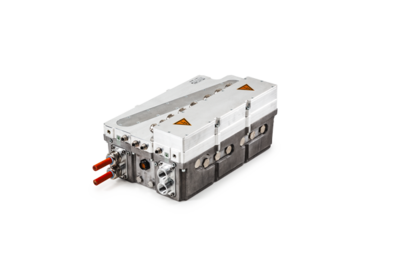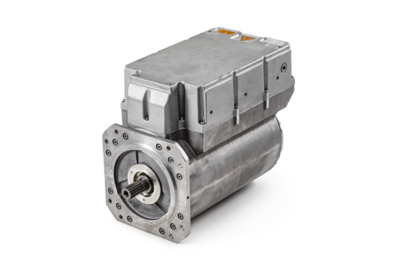The electrification of vehicles is the number one topic in the development departments and the main subject of many conferences. In particular in case of mobile machines, electric drives promise new, innovative solutions, whereby not only energy savings play a major role any more. Noise emissions and pollutant reductions are also the main focuses of attention. In the same way, the substantially simplified energy distribution, good control characteristics and high dynamics permit simpler designs and lead to completely new functions and approaches for the optimization of drives and working processes on mobile machines. An increasing number of electric drive solutions are being developed as required due to the rising customer demands.
The shunting specialist Vollert from Weinsberg in southern Germany has faced up to the challenge, and has built a shunting robot DER 120 with a diesel-electric drive system. In the Hatschek cement works in Gmunden, Austria, this robot ensures safe and environmentally-friendly loading operation in daily operation. The new drive technology with variable speed promises a substantially reduced fuel consumption and therefore more economic viability long-term. With a traction force of 120 kN, the 180 kW diesel engine offers sufficient shunting power. The water-cooled 6-cylinder in-line engine with turbocharging, loading air cooling and external exhaust gas return thus guarantees the exhaust gas emission standard EU Level III B or Tier 4 with particle filter, optionally also EU Level IV. The solid frame is a robust welded construction in accordance with the valid DIN and railway standards. The comfortable cabin has ergonomically arranged operating elements, an air conditioning system and an effective sound insulation.
The speed of the diesel engines adapts continuously to the required performance. This is made possible through the powerMELA drive system by Sensor-Technik Wiedemann GmbH (STW). With the same performance values, the use of smaller diesel engines is made possible, which further reduces the consumption. The powerMELA drives are designed in 4-quadrant operation and can thus be used both as the generator and as the motor. The powerMELA generator is connected to the diesel engine via a transfer case. This converts the mechanical energy generated by the diesel into electrical energy, and thus supplies the drive motors. These are combined with a spur gear, and drive the axles.
Compact electric motors with integrated inverter
STW develops and produces components for successful electrification, which are used in forestry or agricultural machines, construction machines and in railway technology. Due to the technology modules and the modular approach of the powerMELA products, the project could be realized very quickly. The system design and application software only had to be adapted to the Green robot. The synchronous motor with its innovative radiator sets new standards with regard to compactness and power/weight ratio. Through the integration of the inverter into the motor housing, a closed unit results which also saves the need for a central control cabinet and which therefore reduces installation effort. The wiring between the inverter and the motor can be left out completely. With an IP69k protection and a structure featuring protective insulation, it is superbly equipped for mobile applications.
The permanently excited synchronous motor has the highest efficiency factor in comparison to other motor technologies. The minimization of the losses is also achieved through the optimum dimensioning and alignment of the motor, electronics and controls. This includes the adaptation of the performance data of the electronics and motor and the best-possible control. These are carried out in the powerMELAC series through a field-orientated control with the MTPA procedure (Maximum Torque Per Ampere). Here, in addition to the Lorentz force of the permanent magnets, the reluctance torque of the motor is used and the motor current is thus minimized. An adaptive control, which takes into account the changes of motor parameters during operation, further contributes towards a higher efficiency factor.
Through the integration of the field weakening operation, the speed range is extended by the factor 2 to 6000 rounds per minute. In this operating range, the full performance is made available, independent of the speed.
System environment for the successful electrification of vehicles
In order to be able to fully utilize the possibilities offered by the electric drives, a system environment is required which guarantees safety and availability. It is not sufficient to simply swap hydraulic components for electric ones.
So as not to overload the individual components and to guarantee stable operation, a power management is expedient. In particular if no battery is available in the DC voltage network on the vehicle, the power inputs and outputs must remain in balance at all times.
So that a generator can be optimally operated on a diesel, a load limit control is required. Without this control, a power reserve must be provided. In this way, the advantages of electrification are minimized because higher diesel speeds are required, and these cannot be utilized to 100%.
In order to guarantee the electrical safety, the system must be protected against overvoltage and inspected for insulation damage. To do this, STW has developed a brake chopper with integrated insulation measurement. The brake chopper connects automatically when the voltage gets too high. In this way, up to 500 kW can be temporarily “chopped”, for example if a lot of kinetic energy is fed via the drives into the system during an emergency braking application.
The electrification in the GreenTech robot will verifiably open up great savings potentials. Although the installation costs are currently even higher than with hydraulic power transmission, the advantages are so obvious that amortizations are possible within a very short time. By switching to the electric drive system, the operator and Vollert were able to secure a technological advantage and a “green image” for the future.



